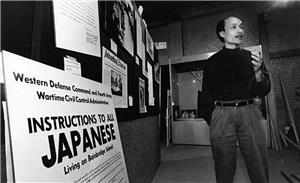In June 1974, the International Examiner begins publishing in Seattle. The newspaper is conceived of by Gerald Yuasa, with the International District Branch of Sea-First Bank, and Lawrence Imamura, proprietor of Officemporium, an office furniture store. They believed a community newspaper was essential for improving the business climate of the District" (Tsutakawa). Later, under editor Ron Chew, the paper became biweekly and covered issues of importance to Asian Americans in the entire region.
George Cox, a Boeing engineer with some writing background, was hired as editor. The first issue had four pages. Larry Imamura handled the business from Officemporium. George Cox wrote the articles and did the paste-up in his West Seattle home. The Examiner had been intended as a monthly, but Cox was not able to devote as much time as he had intended to getting the paper out.
Cannery Workers
In early 1975, the Examiner came under new ownership. The Alaska Cannery Workers Association, formed by Nemesio Domingo Jr. and Silme Domingo (d. 1981) and other young cannery workers to combat racial discrimination in the canneries, had an office across the street from the Officemporium. "Nemesio Domingo, Jr. became interested in the idea of a community newspaper for the International District and soon began talking to Larry Imamura and George Cox about the possibly of taking over the Examiner. After a couple of meetings, a deal was struck for $1 and the Examiner became the property of the Alaska Cannery Workers Association" (Tsutakawa).
A Voice of Activism
Elaine M. Ko, Gary Iwamoto, and Ron Chew were recruited from the University of Washington Editorial Journalism school. Seven or eight people served as staff. The first issue came out in April 1975, and the issue treated workers' rights, anti-racism, housing, and redevelopment, with Ko and Iwamoto writing most of the stories. The newspaper had the tone and feel of grassroots activism.
Gradually through the late 1970s, the paper "underwent a metamorphosis of sorts -- from grassroots Asian activism to a more rounded perspective of general interest which focused not only on political issues affecting the community but on social, historical, and cultural interests as well" (Iwamoto).
By 1977, the paper had increased to an eight page monthly paper. In 1978, the paper broke away from the Alaska Cannery Workers Association and moved from the ACWA office into the Jackson Building. It began to be issued twice a month.

